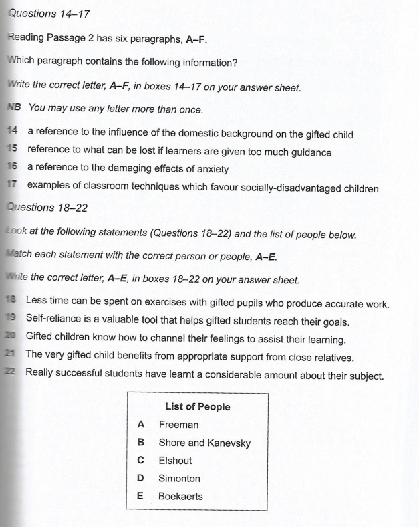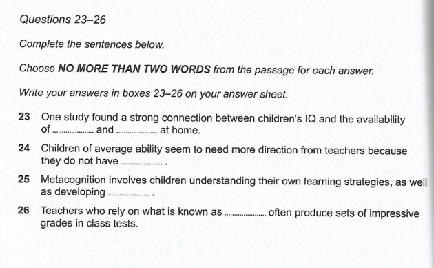剑桥雅思10阅读:Test2雅思阅读PASSAGE2真题+答案+解析
发布时间:2021-02-25 关键词:Gifted Children and Learning
A Internationally, 'giftedness' is most frequentlydetermined by a score on a general intelligence test, known as an IQ test, which is above a chosen cutoff point, usually at around the top 2-5%. Children's educational environment contributes to the IQ score and the way intelligence is used. For example, a very close positive relationship was found when children's IQ scores were compared with their home educational provision(Freeman, 2010). The higher the children's IQ scores, especially over IQ 130, the better the quality of their educational backup, measured in terms of reported verbal interactions with parents, number of books and activities in their home etc. Because IQ tests are decidedly influenced by what the child has learned, they are to some extent measures of current achievement based on age-norms; that is, how well the children have learned to manipulatetheir knowledge and know-how within the terms of the test.The vocabulary aspect, for example, is dependent on having heard those words. But IQ tests can neither identify the processes of learning and thinking nor predict creativity.
B Excellence does not emerge without appropriate help.To reach an exceptionally high standard in any area very able children need the means to learn, which includes material to work with and focused challenging tuition -and the encouragement to follow their dream. There appears to be a qualitative difference in the way the intellectually highly able think, compared with more average-ability or older pupils, for whom external regulation by the teacher often compensates for lack of internal regulation. To be at their most effective in their self-regulation, all children can be helped to identify their own ways of learning -metacognition - which will include strategies of planning, monitoring, evaluation, and choice of what to learn.Emotional awareness is also part of metacognition, so children should be helped to be aware of their feelings around the area to be learned, feelings of curiosity or confidence, for example.
C High achievers have been found to use self-regulatory learning strategies more often and more effectively than lower achievers, and are better able to transfer these strategies to deal with unfamiliar tasks. This happens to such a high degree in some children that they appear to be demonstrating talent in particular areas. Overviewing research on the thinking process of highly able children, (Shore and Kanevsky, 1993) put the instructor% problem succinctly: 'If they [the gifted] merely think more quickly, then we need only teach more quickly. If they merely make fewer errors, then we can shorten the practice'. But of course, this is not entirely the case; adjustments have to be made in methods of learning and teaching, to take account of the many ways individuals think.
D Yet in order to learn by themselves, the gifted do need some support from their teachers. Conversely, teachers who have a tendency to 'overdirect' can diminish their gifted pupils' learning autonomy. Although #spoon-feeding, can produce extremely high examination results, these are not always followed by equally impressive life successes. Too much dependence on the teacher risks loss of autonomy and motivation to discover. However, when teachers help pupils to reflect on their own learning and thinking activities, they increase their pupils' self-regulation. For a young child, it may be just the simple question 'What have you learned today?' which helps them to recognise what they are doing. Given that a fundamental goal of education is to transfer the control of learning from teachers to pupils, improving pupils’ learning to learn techniques should be a major outcome of the school experience, especially for the highly competent.There are quite a number of new methods which can help, such as child-initiated learning, ability-peer tutoring, etc.Such practices have been found to be particularly useful for bright children from deprived areas.
E But scientific progress is not all theoretical, knowledge is also vital to outstanding performance: individuals who know a great deal about a specific domain will achieve at a higher level than those who do not (Elshout, 1995). Research with creative scientists by Simonton (1988) brought him to the conclusion that above a certain high level, characteristics such as independence seemed to contribute more to reaching the highest levels of expertise than intellectual skills, due to the great demands of effort and time needed for learning and practice. Creativity in all forms can be seen as expertise mixed with a high level of motivation (Weisberg, 1993).
F To sum up, learning is affected by emotions of both the individual and significant others. Positive emotionsfacilitate the creative aspects of learning and negative emotions inhibit it. Fear, for example, can limit the development of curiosity, which is a strong force in scientific advance, because it motivates problem-solving behaviour. In Boekaerts’ (1991) review of emotion in the learning of very high IQ and highly achieving children, she found emotional forces in harness. They were not only curious, but often had a strong desire to control their environment, improve their learning efficiency, and increase their own learning resources.
A 国际上,“天才”通常是由一项通行的智力测试的分数决定的,这项测试就IQ测试。达到某个分数的人可被称作天才,他们通常是最的那2-5%。儿童的教育环境会影响IQ分数,以及他们发挥智力的方式。例如,把儿童的IQ分数和家庭教育的优劣进行比较,人们发现两者是正相关的(Freeman, 2010)。儿童的IQ分数越高,特别是超过了130分之后,他们的教育后备质量就越高。(教育后备质量)测量的方面包括和父母的语言交流、家中图书的数量和活动的数量等。因为IQ分数是直接由孩子学到的东西所决定的,它们在某种程度上是各年龄段孩子能力的衡量指标,即他们熟练应用知识和方法的能力。以词汇方面为例,成绩的高低和是否听说过这些词有关。但IQ测试既不能鉴别学习、思考的过程,也不能预测创造性。
B 达到卓越需要适当的助力。要想在任何一个领域达到高的标准,天赋高的儿童也需要借助学习方法,这包括学习材料和有针对性有挑战性的指导,以及对他们梦想的鼓励。智商高的孩子和比较平庸的孩子或年龄较大的孩子相比,在思考方式上呈现质的不同,对后者来说老师施加的外部约束弥补了自我约束的不足。为了达到最有效的自我约束,可以帮助每个孩子确立自己的学习方式,即后设认知能力,这包括计划、监督、评估和选择学习内容的策略。情感认知也是后设认知的一部分,所以应该帮助孩子们明白他们对所学领域的感觉,例如好奇或有信心。
C 人们发现成绩较好的人比成绩不好的人更频繁更有效地应用自我约束学习策略,并且可以地应用这些策略处理不熟悉的任务。某些儿童将这些策略应用得很棒,以至于在某一领域展现出了天赋。(1993年,Shore和Kanevsky的)一项针对高能儿童思考过程的研究对教育者的问题进行了概述:如果天赋高的儿童只是思考的速度更快,那么我们只需教得更快。如果他们只是犯错较少,那么我们可以缩短联系的时间。但是,这并不是全部;教育者们必须考虑到个体思考的多种方式,并相应调整教学方法。
D 为了学会自学,天才儿童确实需要来自老师的帮助。相反地,那些过度指导的老师会削弱天才儿童的学习自主性。尽管填鸭式教学可以带来,但这些学生并不都能在社会上取得同样高的成就。过度依赖老师会削减自主性,并减弱探索的动力。但是,当老师帮助学生反思自己的学习和思考活动时,这就加强了学生的自我约束力。对于一个小孩来说,一个简单的问题“你今天学了些什么?”就能帮助他们意识到自己在做什么。教学的基本目标是把学习掌控方从老师转移到学生身上,改善学生的学习策略应该成为学校的主要作用之一,尤其是对于能力高的学生而言。有一些新方法可以帮助做到这一点,例如儿童自发式学习、同伴辅导等。这些做法对贫困地区的聪明孩子尤其适用。
E 但是,科学的过程仅靠理论是不可取的,知识对取得卓越的表现也很重要:那些在某个领域知识渊博的人会比那些知识贫瘠的人成就更高(Elshout,1995)。(1988年)西蒙顿通过和一些有创造性的科学家进行研究,从而得出结论:在更高层面上,比起心智技能,包括独立性在内的各种特质似乎对达到专业领城的高峰更有帮助,这是因为学习和练习需要大量的精力和时间。创造性可以看成是专业能力融合强大驱动力的结果(Weisberg,1993)。
F 总之,学习既受到个人情绪的影响,也受到其他重要人物情绪的影响。积极的情绪能激发学习的创造性,而负面的情绪则会抑制它。例如,恐惧会限制好奇心的增长,而好奇心是科学进步的强大推动力,因为它会激发人们去解决问题。在波克特(1991年)针对高IQ和成绩好的儿童的情绪研究中,她发现了情绪的力量。他们不仅有好奇心,而且有控制环境、学习效率和扩充自己的学习资源的强烈意愿。


Question 14
参考译文:提到了家庭背景对天才儿童的影响。难度及答案:难度低,答案为 A。
关键词:domestic background
定位原文:A 段第 3 句“For example...home educational provision(Freeman,2010).” 比如,我们会发现孩子的智商水平和他们所接受的家庭教育有很密切的关联(Freeman,2010).
解题思路:题目中的 domestic background 与原文中的home educational provision 是同义表达,此段后面进一步说明天才儿童与其家庭环境的关系。
Question 15
参考译文:暗示如果学习者被给予太多指导,某些东西就会缺失。难度及答案:难度低;答案为 D
关键词:loses、 too much guidance
定位原文:D 段第 2 句“Conversely, teachers who have...pupils’ learning autonomy.” 反言之,那些喜欢“过分指导”的老师会降低有天赋学生的学习自主性。
解题思路:段落 D 当中的 overdirect 相当于题干中的 too much guidance, diminish... autonomy 指的就是 what can be lost。
Question 16
参考译文:焦虑的破坏性影响的提及。难度及答案: 难度低;答案为 F
关键词:damaging effects s anxiety
定位原文 : F 段 第 2 、 3 句 “ Positive emotions facilitate … it motivates problem-solving behaviour.”积极的情绪可以促进学习的创造力,而消极的情绪则抑制了创造力。比如说恐惧会限制好奇心的发展,而好奇心恰恰是科学进步的重要推动力,因为它能够鼓励解决问题的行为。
解题思路:此段中提及了消极情绪,例如 fear 对好奇心的抑制,不利于好奇心的培养。而题目中的 anxiety 与 fear 是同义词,都是消极的情绪。
Question 17
参考译文: 有利于社会地位较低的孩子的课堂技巧的例子。难度及答案: 难度低;答案为 D
关键词: techniques 、socially-disadvantaged
定位原文: D 段最后一句 “Such practices have been…from deprived areas.” 我们发现这样的实践对贫困地区的聪明孩子尤其有用。
解题思路: 题目当中的 socially-disadvantaged children 相当于原文中的 children from deprived areas, favour 指的就是 be particularly use for 、 classroom techniques 对应于原文中的 such practices。本题出现了大量的同义替换的设置。
Question 18
参考译文: 能准确完成学习任务的天才学生可以在练习上少花时间。难度及答案: 难度低;答案为 B
关键词: less time 、 accurate work
定位原文:C 段第 3、4 句“Overviewing research on the... teach more quickly.”,纵览关于能力出众的孩子的思维模式的研究(Shore and Kanevsky,1993),它更精确地指出教育者的问题:“如果他们(有天赋的孩子)仅仅思考得更快,那么我们只需要推进教学的进度。如果他们仅仅越来越少犯错,那么我们需要减少练习的时间。"
解题思路: 此题型应先浏览全文,找到选项中的人名在题目中的位置。题目当中的 accurate work 与原文当中的 fewer errors 相对应。题干当中的 less time spent on exercise 相当于 shorten the practice。所以答案择 B。
Question 19
参考译文: 自我依靠是有价值的工具,它可以帮助天才学生实现目标。难度及答案: 难度低;答案为 D
关键词: self-reliance 、reach their goal
定位原文: E 段第 2 句 “Research with creative...for learning and practice.” Simonton(1998)关于有创意的科学家的研究让他有了这样一个结论:在的水平之上,性格特征诸如独立,比起智力在寻求水平的专业知识方面发挥的作用更大,因为学习和练习需要大量的精力和时间。
解题思路: 题目当中的 self-reliance 与文章中的 independence 是对应的关系,而题目中的 reach their goal 与文中的 reach the highest levels of expertise 也是对应关系 。
Question 20
参考译文: 天才学生知道怎么引导他们的情绪从而辅助学习。难度及答案: 难度低;答案为 E
关键词: feeling、 assist、 learning
定位原文:F 段最后两句“In Boekaerts’(1991)... their own learning resources.” 在 Boekaerts (1991)关于在智商很高和学习成果的孩子的情绪回顾上,她发现情绪力量是很重要的。他们不仅仅是好奇的,而且经常有强烈的欲望去控制自己的环境, 改善学习效率以及增加他们的学习资源。
解题思路: 题目当中的 channel their feeling 指的就是原文当中的 emotional forces in harness。原文当中最后一句的论述表达的就是控制情绪对学习的辅助作用。
Question 21
参考译文: 特别天才的学生获益于近亲的适当支持。难度及答案: 难度高;答案为 A
关键词: benefit、support、close relatives
定位原文:A 段第 3、4 句和 B 段第 1 句“For example…not emerge without appropriate help,比如,我们会发现孩子的智商水平和他们所接受的家庭教育有很密切的关联(Freeman, 2010)。孩子的智商水平越高,尤其是高于 130 的时候,他们所得到的预备教育的质量就越高,其质量是以孩子与父母的语言交流,还有他们家中书的数量和活动衡量的……适当的帮助才能让人变得。
解题思路: 此题需联系属于不同段落的两个句子,并且要进一步思考,才能得出题目中的结论,属于比较难的題。
Question 22
参考译文: 真正成功的学生对于他们的学科有的认知了解。难度及答案:难度低;答案为 C
关键词: successful student、a considerable amount、subject
定位原文: E 段第 1 句 “But scientific progress…do not (Elshout,1995).”,但是科学过程并不总是理论式的,知识对一个人优异的表现也是关键的:那些对某一领域认知很深入的人会比对此没有认识的人水平更高(Elshout, 1995)。
解题思路:题目中的 a considerable amount 相当于原文中的 a great deal about,题目当中的 subject 与原文中的 a specific domain 意思相同。
Question 23
参考译文: 一项研究表明儿童的智商与家中___和____的可获得性有深度的关联。难度及答案: 难度低;答案为 books (and) activities
关键词: connection、at home
定位原文: A 段第 3、4 句 “For example…activities in their home etc.” 比如,我们会发现孩子的智商水平和他们所接受的家庭教育有很密切的关联(Freeman,2010)。孩子的智商水平越高,尤其是高于 130 的时候,他们所得到的预备教育的质量就越高,其质量是以孩子与父母的语言交流,还有他们家中书的数量和活动衡量的。
解题思路: 此题要填两个表未并列关系的词,考生可以定位 at home 到 A 段第 3 句,发现 a very close positive relationship 与 strong connection 意思一致,此句中可以表示异列关系的只有 books 和 activities。
Question 24
参考译文: 能力平庸的孩子看起来需要的教师指导,因为他们没有____. 难度及答案: 难度中等;答案为 internal regulation/self-regulation
关键词: average ability、do not have
定位原文: B 段第 3 句“There appears to be a …internal regulation.”看上去智商高、能力强的孩子和那些智力平庸或年纪稍大的小学生之间有着质的区别,因为后者会需要老师给出外在的规范以弥补他们自我约束的缺乏。
解题思路: 题目当中的 children of average ability 可以定位到原文中 B 段第 3 句,而且 lack of 与题目当中的 do not have 是同义替换。因此填写 international regulation.
Question 25
参考译文:元认知涉及儿童对他们学习策略的理解以及开发____. 难度及答案: 难度中等;答案为 emotional awareness
关键词: metacognition、learning strategies
定位原文: B 段 倒数 句“ Emotional awareness is... or confidence for example." 情感认知也是元认知的一部分,所以,举个例子来说,孩子必须有人帮助他们认识对即将学习的领域的感受,比如觉得好奇或者自信的感受。
解题思路: 考生可以用 metacognition 来定位到 B 段的最后一句话,可以知道元认知包括 ways of learning 会以及 emotional awareness。
Question 26
参考译文: 依靠___教学的老师常常在班级测验中得到喜人的成绩。难度及答案: 难度低,答案为 spoon-feeding
关键词:rely on、 impressive grades
定位原文: D 段第 3 句 “Although 'spoon-feeding’ can produce... impressive life successes.” 因为“填鸭式”的教学会产生的考试结果,但这并不意昧着人生同等的成功。
解题思路: 题目当中的 impressive grades in class tests 相当于文章中的 high examination results,而后者是由 spoon feeding 产生(produce ) 的。




